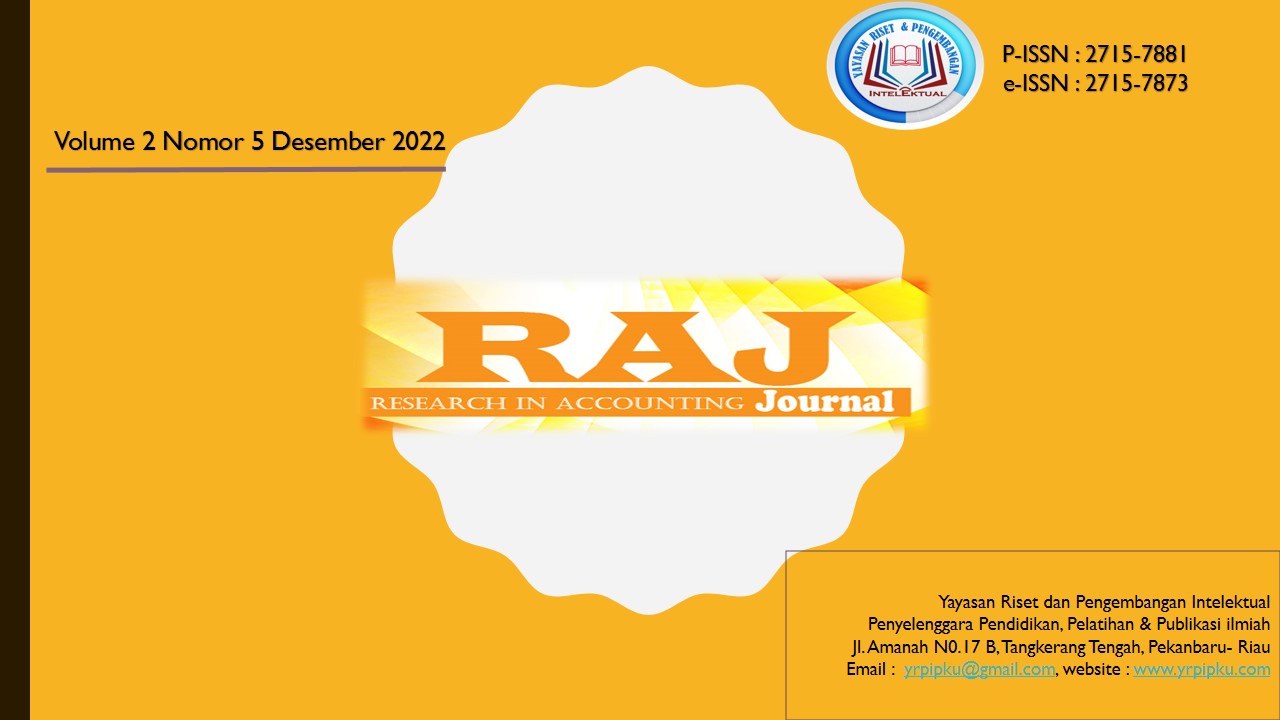Seberapa Efektifnya Pencatatan Laporan Keuangan Pada Kantin Tata Universitas Muhammadiyah Riau?
DOI:
https://doi.org/10.37385/raj.v2i5.1588Keywords:
Financial reports, target coasting, SMEsAbstract
The financial statements of an SME have a major influence on cost management, where all cost management activities need to be recorded so that it can be seen how well the company has developed both in terms of income and expenses. This study aims to improve the recording of production costs from direct raw materials, indirect raw materials to overhead costs through optimizing financial reports. In addition, realizing that accurate financial reports are very important for implementing SMEs, so that they know financial reports are not only for recording transactions but to be able to see the competitiveness of other SMEs. In this study using qualitative methods in carrying out observations on the part of the informants. As a resource that has been discussed previously, namely the Tata cafeteria, they will provide an explanation of the financial reports they use. Before giving directions to the informants, we surveyed the location with the aim of obtaining the problems/issues we got. There are two sources of data used, namely primary data and secondary data. The primary data consists of calculating the cost of production using the target costing method and supporting data sources derived from interviews with the owner of the tata canteen. While the secondary data consists of detailed data on raw material costs, direct labor costs, factory overhead costs, non-production costs and other supporting data.
References
Doloksaribu, H., & Kalalo, M Teknik Pengurangan Biaya dengan Tujuan Meningkatkan Produktivitas dalam Pencapaian Laba yang Maksimum. (2016)., 16(03), 635–646.
Bustami, B., & Nurlela, N. (2010). Akuntansi Biaya (Edisi 2). Mitra Wacana Media.
Darmayasa, G., Sujana, I. N., & Haris, I. Ak. (2019). Analisis Penerapan Target Costing dalam efisiensi Biaya Produk Batako pada UD darma Yasa. USA: Addison-Wesley Publishing Company, Inc
Arifin, N. I., Karamoy, A. Lastri & Simanjuntak, N. M. (2018). Akuntansi Manajerial. Universitas Sam Ratulangi Manado. Universitas HKBP Nommensen, 2(2), 236–242.
Hansen, D. R., & Mowen, M. M. (2009). Analisis Target Costing dalam Upaya Pengurangan Biaya Produksi untuk Peningkatan Laba Kotor pada Mandala Bakery. Buku Kedua. Jakarta: Salemba Empat
Ahmad, F., & Abdullah, W. (2009). Akuntansi Biaya, Edisi 2. Jakarta: Salemba Empat
Blocher, E. J., Stout, D. E., & Cokins, G. (2011). Manajemen Biaya Penekanan Strategis, Jilid 1, Edisi 5. Jakarta: Salemba Empat Pendidikan Ekonomi, 11(2). 5thEd.
Bustami, B., & Nurlaela. (2010).Akuntansi Biaya. Yogyakarta; Graha Ilmu Copeland, T. E., & Weston, J. F. (1992). Financial Theory and Corporate Policy,
Hanafi, M. M. (2010). Manajemen Keuangan, Cetakan Kelima. Yogyakarta: BPFE Hansen, H., & Mowen, M. (2004). Manajemen Biaya, Edisi Bahasa Indonesia, In D. A. Kwary (Ed.), Akuntansi Manajerial (Edisi 8). Salemba Empat.



